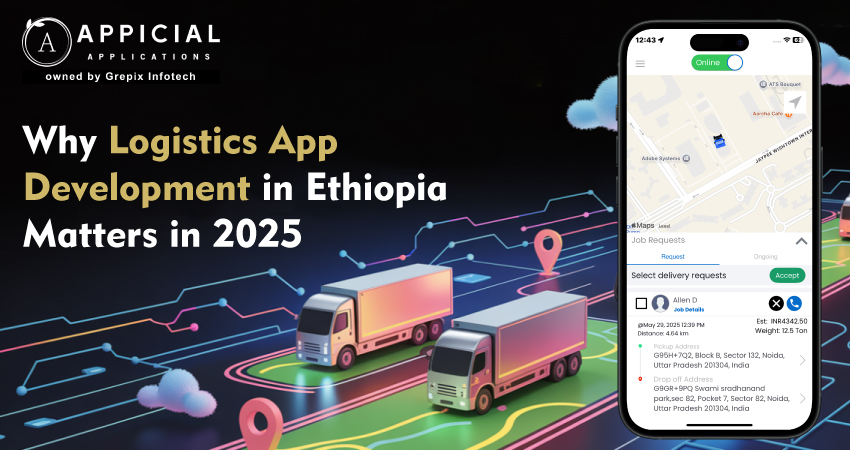
Why Logistics App development in Ethiopia Matters in 2025
Ethiopian logistics still face many challenges. Delivery delays are frequent. Drivers and dispatchers may talk hurriedly or not at altogether. To manage something as difficult as shipping goods across crowded cities or rural towns, many businesses still rely on antiquated techniques like pen and paper, text messages, or phone calls.
As a result, it's difficult to satisfy customers' growing expectations. The pace is slow. Packages vanish. Drivers don't always know the best routes. Consumers are not informed of the location or anticipated time of arrival of their orders. It's frustrating for everyone.
It's good to see Ethiopia changing. Act quickly. Every day, more people use the internet. Even in far-flung places, smartphones are widely used. Businesses are growing increasingly tech-savvy. Reliable delivery services are becoming more and more in demand as cities like Addis Ababa grow quickly.
This evolution unlocks opportunities for digital solutions, and logistics apps are leading the way. All the moving components, deployers, drivers, clients, and business owners can be connected by these apps. They streamline, expedite, and greatly increase the efficiency of logistics through digital records, route planning, and real-time updates.
Developing a logistics app in Ethiopia in 2025 is not only a good idea but also a timely one. The necessity exists. The market is prepared. And it's easier than ever to get the technology to make it happen.
Ethiopia's economy is expanding slowly, and as a result, there is a huge demand for trustworthy logistics. Logistics is at the center of everything, from small businesses transporting goods across cities to local stores delivering groceries. But right now, it’s not working as well as it could. Many logistics companies still use old-fashioned methods. Drivers keep handwritten logs. Managers coordinate routes by phone. Deliveries are tracked using simple chat apps, if they’re tracked at all. The result? Delays, confusion, and missed opportunities. That’s where mobile logistics apps can make a real difference. These apps bring everything into one place: dispatching, tracking, payments, and customer communication. They help businesses grow, cut down on delivery times, and improve the overall experience for everyone involved. We'll look at why 2025 is the ideal year to create a logistics app in Ethiopia in this blog. We'll examine the essential features your app should have, potential problems to look out for, the type of technology you'll need, and the potential cost. Above all, we'll demonstrate how a competent development team can assist you in creating a durable product.
Why Invest in Logistics App Development in Ethiopia?
Here are the reasons that show why it is the right time to invest in a logistics app:
Smartphones Are Everywhere
The extent of human interconnectedness is readily apparent. In both big and small cities, Ethiopians use their phones for internet browsing, money transfers, and online shopping. Mobile applications are now a commonplace aspect of daily life.
However, logistics has yet to catch up. Why can't shipment delivery be managed the same way that people use apps to pay their bills, book taxis, and order food? A mobile logistics app, which gives businesses the tools they need to remain competitive with mobile-first customers, is a good fit for this shift.
Most Logistics Are Still Manual
Many logistics companies continue to use antiquated systems in spite of rising demand. Spreadsheets, lengthy phone conversations, WhatsApp messages, and paper logs are all typical. These tools can't keep up with operations that move quickly, are difficult to scale, and are prone to mistakes.
A logistics apps simplifies everything. Drivers can get turn-by-turn directions, dispatchers can delegate tasks instantly, and customers can track their orders in real time. No more miscommunications. Don't overlook any additional updates. Only effective operations.
Cities Are Growing Fast
Other cities are growing besides Addis Ababa. Ethiopia is urbanizing. The need for dependable, quick delivery of goods like electronics, food, clothing, and medications is growing as more people move into cities.
Businesses require more intelligent tools to manage routes and supervise deliveries as traffic volumes rise and routes become more intricate. In these expanding cities, an app that provides real-time GPS tracking, intelligent route planning, and delivery status updates might become game-changing.
The Market Is Still Wide Open
Ethiopia is still in its infancy, in contrast to other nations where the market for logistics apps has exploded. This suggests that there is room for leadership and inventiveness. You can take control of the market before it gets crowded by developing a top-notch app now.
Starting from scratch is not necessary. Just solve real problems. Create something local, affordable, and reliable. If you do, the market is yours.
The Government Supports Digital Solutions
The Ethiopian government is actively promoting digital transformation. Now is an excellent occasion to invest in tech-driven solutions because fintech, eCommerce, and startup culture are all growing. Developing a logistics app is in line with national objectives and could lead to future collaborations, funding, or support.
What are the Must-Have Features for a Logistics App?
A great app makes everyone’s life easier, including drivers, dispatchers, and customers. Here’s what you need:
For Admins
- Dashboard with all activities
- Add and manage drivers
- Track orders and vehicles
- Get reports and insights
For Drivers
- See tasks in real-time
- GPS with the best routes
- Mark deliveries done
- Chat with dispatchers
For Customers
- Live tracking (yes, actual delivery tracking apps)
- Estimated delivery times
- Order history
- Payment options
Simple. Clean. Fast. That’s what people want.
What is the Technology Stack and Architecture?
You don’t need to be a developer to get this. But it helps to know the basics.
Frontend (what users see)
- Use Flutter or React Native for apps
- Use React or Angular for web dashboards
Backend (how the app works)
- Node.js, Laravel, or Python
- Use PostgreSQL or MongoDB to store your data
Extras
- Google Maps API for routes
- Twilio or Firebase for alerts
- Stripe or Flutterwave for payments
- AWS for hosting the app
This stack is fast, reliable, and scalable. Perfect for growing apps and real-time features like last-mile delivery tracking.
Also Read: How food delivery app development in Morocco is Reshaping Mealtime
What are the Challenges and Market Gaps in Ethiopia?
No market is perfect. Ethiopia has a few unique challenges. But that’s also what makes it full of potential.
Poor Infrastructure
Some roads are rough. That slows deliveries. Your app can help with smart routing and time estimates.
Low Tech Skills in Logistics
Not every driver is tech-savvy. Your app should be super simple. Big buttons. Local languages. No fluff.
No Real-Time Visibility
Businesses often don’t know where their goods are. A good delivery tracking app can change that overnight.
Disconnected Systems
Many logistics companies run in silos. You can build an app that brings everything together: orders, routes, fleet management, and communication.
Estimated Development Cost & Timeline
Let’s talk numbers. How much will it cost? And how long will it take?
Basic App
- Includes tracking, task updates, and an admin panel
- Takes around 1–2 months
- Cost: $15,000–$25,000 USD
Advanced App
- Includes analytics, payments, chat, and AI-based routing
- Takes 1–2 months
- Cost: $30,000–$60,000+ USD
Don’t forget extras like server costs, updates, and support.
Pro tip: Build the MVP (minimum viable product) first. Add fancy stuff later.
How Appicial Applications Can Help?
At Appicial Applications, we’ve helped companies launch delivery and fleet management platforms all over the world.
Here’s what we bring to the table:
- Fully customizable logistics apps
- Built-in features like supply chain tech, live tracking, payments, and more
- Local-friendly options (Ethiopian language, payment systems, etc.)
- Scalable tech stack
- Fast delivery, clear pricing, and ongoing support
We don’t just build apps, we build success stories. And we’d love to build yours too.
Conclusion
2025 is the year logistics in Ethiopia can go digital. Fast-growing cities. Tech-ready users. A big gap in the market.
Everything suggests that the time has come to introduce your logistics app.
You can solve real issues and expand a real business with the correct features, a simple design, and reliable technology. You can take the lead in supply chain tech, fleet management, or last-mile delivery.
Therefore, don't wait for the other person to finish it. Let’s get started with Appicial Applications today!
FAQs
Author's Bio

Vinay Jain is the Founder at Grepix Infotech and brings over 12 years of entrepreneurial experience. His focus revolves around software & business development and customer satisfaction.
Back to blog list




